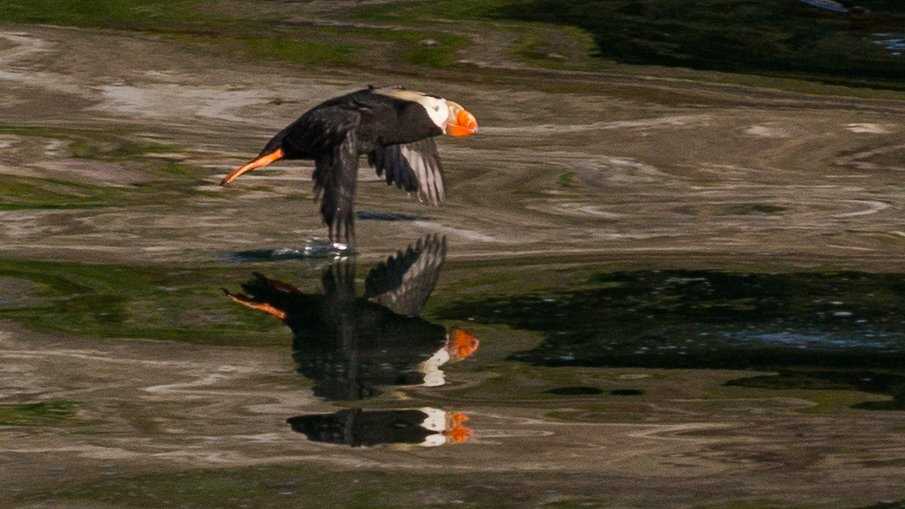Our run of fabulous weather has continued. May is typically one of the driest months here in Southeast Alaska and from the very onset of the day it appears that we're experiencing the pinnacle of those conditions. In seven years of visiting Glacier Bay National Park at various times of the season I can't recall having seen it in a completely cloudless state. Now that's not to say that the remainder of the day won’t see a change in weather as we navigate over 60 miles one way “up bay” towards the Margerie and Grand Pacific Glaciers, but we'll keep our finger crossed. We boarded our National Park Service Rangers and Tlingit Cultural Interpreter before breakfast and set out for the day.
Glaciers have shaped all of the land and seascape we've been traveling through these past 11 days, and here in Glacier Bay National Park we have experienced and learned just how that process has unfolded over the millennia. In fact less than 300 years ago one massive glacier filled what is now Glacier Bay. By the time John Muir visited this area in the late 1870s the ice had receded nearly 50 miles. Our first sight this morning of interest was at South Marble Island. This small, mostly bare, granite island is teeming with life, with nesting seabirds and a healthy population of Steller sea lions. This morning we were fortunate to have excellent sightings of tufted puffins. These clown-like members of the Alcid family were coming and going from their nesting burrows as well as rafting up on the water near the island. Gulls, cormorants, and common murres are also plentiful here and occasional cries of the black oystercatcher were heard. Meanwhile the bellows of the sea lions rang out from their haul out rocks adding an extra element to this sensory explosion.
Further up bay we approached a conspicuous rock formation affectionately called, Gloomy Knob, its bubbling gray marble striped granite face nearly void of vegetation while adjacent slopes lie blanketed in forests and shrubs. As we drew near three humpback whales surfaced very near the shore forcing us to alter our course in order to not disturb these leviathans. Once clear we were able to get a closer look at this geological feature. Our attention was soon fixed on the creamy white objects scattered about the ledges and resting in the shade of the rocks and limited shrubby vegetation. Soon legs, heads, and even small horns were discernible. Mountain goats! Calling this protected and inaccessible cliff face home, these well adapted animals of the precipitous terrain paid no attention to our approach from the sea. However just as we were departing another figure of this landscape surfaced, a brown bear! With what was sure to be a vain attempt the bear lumbered down the slope and the goats took action achieving the most inaccessible perches for protection. We didn't linger to watch the drama unfold but these goats have a time-tested defense against such rash behavior.
As lunch drew to a conclusion we were nearing our goal for the day’s journey, the back of Tarr Inlet and the glaciers that still lie there. Coming in from the west side of the inlet thousands of black-legged kittiwakes fluttered around their nesting colony and the snout of the Margerie Glacier protruded out in to the inlet. Very ominous slabs of ice hung like frozen breaking waves seemingly defying the forces of nature that govern us all. The bow filled with onlookers, the sky still void of any hint of clouds, and ancient ice began to rumble, pop, and ultimately crash down into the silty water below. The once massive Grand Pacific glacier now rests far back from the sea, with only its rock strewn moraine visible and like nearly all the glaciers here the Margerie is marching backwards as well, soon to be left high and dry in its valley. The show of ice and rock raining down, though impressive is sadly a powerful reminder of the alarming trend of glacial retreat worldwide.
Heading back down the bay we made one last detour before heading back to Bartlett Cove. Peeling off the main bay we sailed up to Jaw Point in Johns Hopkins Inlet to get a stunning look at the only advancing glacier here, of the same name. Even from a distance it is an incredible scene and looking back at the massive peaks responsible for catching the snowfall that's making this glacier reach back out an reclaim the fjord it's carved out.
Our day concluded back at Bartlett Cove where we started, over 130 miles of glacial and geological time and not a cloud in sight.







